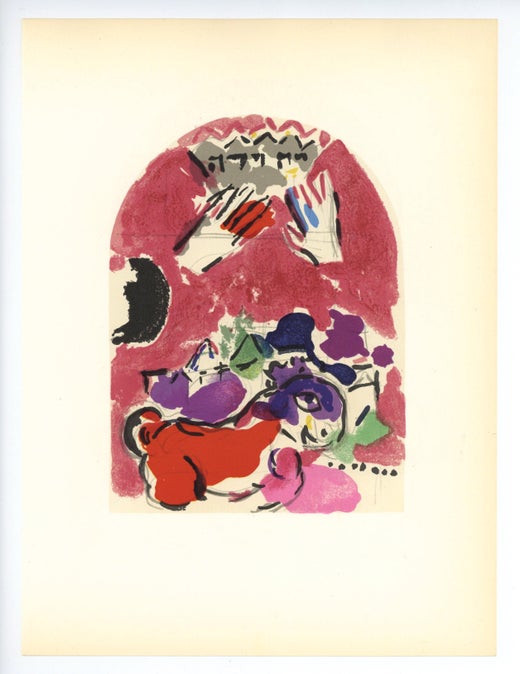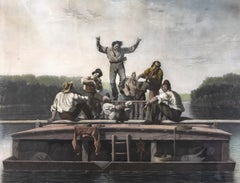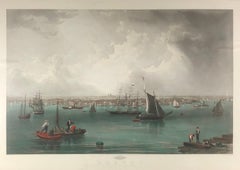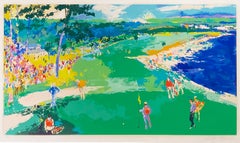Want more images or videos?
Request additional images or videos from the seller
1 of 10
(after) Marc ChagallRomeo et Juliette (Signed)1964
1964
About the Item
- Creator:(after) Marc Chagall (1887 - 1985, French, Russian)
- Creation Year:1964
- Dimensions:Height: 38 in (96.52 cm)Width: 52 in (132.08 cm)
- Medium:
- Movement & Style:
- Period:
- Condition:
- Gallery Location:Missouri, MO
- Reference Number:1stDibs: LU74732561701
(after) Marc Chagall
Marc Chagall was a renowned Jewish artist born July 7, 1887, in Vitebsk, Russia, who later moved to Paris and gained French citizenship. Chagall studied at the Imperial Society for the Protection of the Arts in Saint Petersburg. He was a member of the Ecole de Paris and was part of the Salon des Indépendants and the Salon d’Automne in the early 1900s. In addition to Paris and St. Petersburg, Chagall traveled and exhibited globally including Amsterdam, Jerusalem, and New York City. Having lived through World War I and World War II, his work was influenced by these events. Chagall’s work is inspired by his Jewish heritage and his hometown of Vitebsk and incorporates elements of Fauvism and Cubism as well as aspects of traditional Russian and Jewish folk art. His work has been exhibited and collected internationally both privately and by institutions including the Guggenheim, the Museum of Modern Art, Centre Pompidou, and Tate Modern.
About the Seller
5.0
Vetted Professional Seller
Every seller passes strict standards for authenticity and reliability
Established in 1970
1stDibs seller since 2017
156 sales on 1stDibs
Typical response time: Several days
Authenticity Guarantee
In the unlikely event there’s an issue with an item’s authenticity, contact us within 1 year for a full refund. DetailsMoney-Back Guarantee
If your item is not as described, is damaged in transit, or does not arrive, contact us within 7 days for a full refund. Details24-Hour Cancellation
You have a 24-hour grace period in which to reconsider your purchase, with no questions asked.Vetted Professional Sellers
Our world-class sellers must adhere to strict standards for service and quality, maintaining the integrity of our listings.Price-Match Guarantee
If you find that a seller listed the same item for a lower price elsewhere, we’ll match it.Trusted Global Delivery
Our best-in-class carrier network provides specialized shipping options worldwide, including custom delivery.You May Also Like
Washington Assumes Command - Etching on Paper
Located in Soquel, CA
Washington Assumes Command - Etching in Ink on Paper
Historical engraving by Ralph Ludwig Boyer (American, 1879-1952). George Washington is shown holding a sword, with an army stand...
Category
1930s Impressionist Figurative Prints
Materials
Paper, Drypoint, Lithograph
"Skating on Ladies' Pond Central Park": Winslow Homer 19th C. Woodcut Engraving
By Winslow Homer
Located in Alamo, CA
This Winslow Homer woodcut engraving entitled "Skating on the Ladies' Skating-Pond in Central Park, New York", was published in Harper's Weekly in the January 28, 1860 edition. It depicts a large number of men, women and children skating on a recently opened pond in Central Park. At the time of publication of this engraving, Central Park was in the early stages of construction. This engraving documents the very early appearance of Frederick Law Olmstead and Calvert Vaux's masterpiece of landscape design. According to Olmsted, the park was "of great importance as the first real Park made in this century – a democratic development of the highest significance". The people of New York were very proud of the plans for their park. It was stated at the time: "Our Park, which is progressing very satisfactorily under the management of the Commissioners, will undoubtedly be, one of these days, one of the finest place of the kind in the world...Those who saw the Park before the engineers went to work on it are amazed at the beautiful sites which have been contrived with such unpromising materials; all fair persons believe that the enterprise is managed with honesty and good taste."
Skating was rapidly rising in national popularity in part due to the opening of Central Park’s lake to skaters on a Sunday in December 1858 with 300 participants. The following Sunday it attracted ten thousand skaters. By Christmas Day, a reported 50,000 people came to the park, most of them to skate. There were rules governing who could use the skating pond. “The Ladies’ Pond...
Category
1870s American Impressionist Landscape Prints
Materials
Engraving, Woodcut
$940 Sale Price
20% Off
H 23.13 in W 29.5 in D 1.13 in
Two Women by a River by Paulémile Pissarro - Wood Engraving
Located in London, GB
SOLD UNFRAMED
Two Women by a River by Paulémile Pissarro (1884 - 1972)
Wood engraving
12.5 x 17.3 cm (4 ⅞ x 6 ¾ inches)
Signed lower left, Paulémile - Pissarro and numbered lower r...
Category
20th Century Impressionist Landscape Prints
Materials
Wood, Engraving
$603
H 4.93 in W 6.82 in
Querelle d'amoureux. (Quarreling). 1
By James Tissot
Located in Storrs, CT
En plein soleil. (In the Sunlight). 1881. Etching and drypoint. Tissot 54, Béraldi 45, Wentworth 54. 7 13/16 x 11 1/2 (sheet 11 1/4 x 15). Edition about 100. Mat line and two hinge s...
Category
19th Century Impressionist Figurative Prints
Materials
Drypoint, Etching
$2,800 Sale Price
20% Off
H 7.82 in W 8.5 in D 0.5 in
Knaresborough
By Sir Frank Short
Located in Storrs, CT
Knaresborough (after a watercolor by Peter De Wint, 1784-1849). c. 1904. Mezzotint. Hardie catalog 80 state ii. 7 7/16 x 11 3/8 (sheet 13 3/8 x 18). A very rich impression, printed o...
Category
Early 1900s Impressionist Landscape Prints
Materials
Mezzotint
Barcarolle.
By James McBey
Located in Storrs, CT
Barcarolle. 1926. Etching. Carter 233. 14 7/8 x 8 3/8 (sheet 17 1/4 x 10 1/4). Edition 80, #xxv. Print Collector's Quarterly 24 (1938): 428; Eric Denker, Reflections & Undercurrents: Ernest Roth...
Category
1920s Impressionist Landscape Prints
Materials
Drypoint, Etching
Degas, Famille Cardinal, E. Degas Monotypes (after)
By Edgar Degas
Located in Fairfield, CT
Medium: Engraving on vélin du Marais paper
Year: 1948
Paper Size: 12.25 x 9.125 inches; image size: 8.5 x 6.25 inches
Inscription: Unsigned and unnumbered, as issued
Notes: From the ...
Category
1940s Impressionist Figurative Prints
Materials
Engraving
$956 Sale Price
20% Off
H 12.25 in W 9.125 in
Degas, Famille Cardinal, E. Degas Monotypes (after)
By Edgar Degas
Located in Fairfield, CT
Medium: Engraving on vélin du Marais paper
Year: 1948
Paper Size: 12.25 x 9.125 inches; image size: 6.24 x 4.75 inches
Inscription: Unsigned and unnumbered, as issued
Notes: From the...
Category
1940s Impressionist Figurative Prints
Materials
Engraving
$956 Sale Price
20% Off
H 12.25 in W 9.125 in
Degas, La Loge, E. Degas Monotypes (after)
By Edgar Degas
Located in Fairfield, CT
Medium: Engraving on vélin du Marais paper
Year: 1948
Paper Size: 12.25 x 9.125 inches; image size: 4.75 x 6.5 inches
Inscription: Unsigned and unnumbered, as issued
Notes: From the ...
Category
1940s Impressionist Figurative Prints
Materials
Engraving
Degas, Le Coucher, E. Degas Monotypes (after)
By Edgar Degas
Located in Fairfield, CT
Medium: Engraving on vélin du Marais paper
Year: 1948
Paper Size: 12.25 x 9.125 inches; image size: 6.5 x 4.75 inches
Inscription: Unsigned and unnumbered, as issued
Notes: From the ...
Category
1940s Impressionist Figurative Prints
Materials
Engraving
More From This Seller
View AllThe Jolly Flat Boat Men
By George Caleb Bingham
Located in Missouri, MO
The Jolly Flat Boat Men, 1847
After George Caleb Bingham (American, 1811-1879)
Engraved by Thomas Doney (French, active New York 1844-1849)
Engraving with Hand-Coloring
Published by The American Art-Union, New York (1838-1851)
Printed by Powell and Co.
18 x 24 inches
32 x 38 inches with frame
In 1847, the American Art-Union purchased Bingham’s painting "The Jolly Flat Boat Men" (1846; National Gallery of Art) directly from the artist. The subscription-based organization, founded in 1838 as the Apollo Association, boasted nearly ten-thousand members at this date. For an annual fee of five dollars, each received a large reproductive engraving and was entered in a lottery to win original artworks exhibited at the Art-Union’s Free Gallery. Aimed at educating the public about contemporary American art, the organization developed an impressive distribution network that reached members in every state. The broad circulation of the Art-Union's print helped to establish Bingham's reputation and made his river scene famous.
Born in Augusta County, Virginia in the Shenandoah River Valley, George Caleb Bingham became known for classically rendered western genre, especially Missouri and Mississippi River scenes of boatmen bringing cargo to the American West and politicians seeking to influence frontier life. One of his most famous river genre paintings was The Jolly Flatboatmen completed in several versions in 1846. This first version of this painting is in the Manoogian Collection at the National Gallery of Art. Fame resulted for this work when it was exhibited in New York at the American Art Union whose organizers made an engraving of 10,000 copies and distributed it to all of their members. Paintings such as Country Politician (1849) and County Election (1852) and Stump Speaking (1854) reflected Bingham's political interests.
In 1819, as an eight-year old, he moved to Boon's Lick, Missouri with his parents and grandfather who had been farmers and inn keepers in the Shenandoah Valley near Rockingham, Virginia. Reportedly as a child there, he took every opportunity to escape supervision to travel the River and watch the marine activity.
His father died in 1827, when his son was sixteen years old. His mother had encouraged his art talent, but art lessons were not easily obtainable. In order to earn money, he apprenticed to a cabinet maker but determined to become an artist. By 1835, he had a modest reputation as a frontier painter and successfully charged twenty dollars per portrait in St. Louis. "His portraits had become standard decorations in prosperous Missouri homes." (Samuels 46). In 1836, he moved to Natchez, Mississippi and there had the same kind of career, only was able to charge forty dollars per portrait.
He remained largely self taught until 1837, when he, age 26 and using the proceeds from his portraiture, studied several months at the Pennsylvania Academy of the Fine Arts. He later said that he learned much of his atmospheric style and classically balanced composition by copying paintings in collections in St. Louis and Philadelphia and that among his most admired painters were Thomas Cole, John Vanderlyn, and William Sidney Mount. Between 1856 and 1859, Bingham traveled back and forth to Dusseldorf, Germany, where he studied the work of genre painters. Some critics think these influences were negative on his work because during that time period, he abandoned his luminist style that had brought him so much public affirmation.
Bingham credited Chester Harding (1792-1866) as being the earliest and one of the most lasting influences on his work. Harding,a leading portraitists when Bingham was a young man, had a studio in Franklin, near Bingham's home town. In 1822, when Bingham was ten years old, he watched Harding finish a portrait of Daniel Boone. Bingham recalled that watching Harding with the Boone portrait was a lasting inspiration and that it was the first time he had ever seen a painting in progress. Harding suggested to Bingham that he begin doing portraiture by finding subjects in the river men, which, of course, opened the subject matter that established fame and financial success for Bingham. Harding also encouraged Bingham to copy with paint engravings. He later painted two portraits of Boone but, contrary to the assertions of some scholars, he did not do Boone portraits in the company of Harding.
Bingham's portraits of Boone are not located, but one of them, a wood signboard for a hotel in Boonville circa 1828 to 1830, showed a likeness of Boone in buckskin dress...
Category
1840s Hudson River School Figurative Prints
Materials
Engraving
Boston
By John William Hill
Located in Missouri, MO
John William Hill (1812-1879)
"Boston" 1857
Hand-Colored Engraving
Site Size: 29 x 41 inches
Framed Size: 39 x 52 inches
Born in London, England, John William Hill came to America with his family at age 7. His father, John Hill, was a well-known landscape painter, engraver, and aquatintist. John William had a career of two phases, a city topographer-engraver and then, the leading pre-Rafaelite school painter in this country. Employed by the New York Geological Survey and then by Smith Brothers...
Category
1850s Pre-Raphaelite Landscape Prints
Materials
Engraving, Aquatint
Price Upon Request
Cove at Vintage
By LeRoy Neiman
Located in Missouri, MO
Cove at Vintage
Leroy Neiman (American, 1921-2012)
Signed in pencil lower right
Edition 237/375 lower left
34 x 36.5 inches
43 x 45.5 inches with frame
Known for his bright, colorful paintings and screen prints of famous sports stars...
Category
20th Century American Modern Landscape Prints
Materials
Color, Lithograph
The 18th at Pebble Beach
By LeRoy Neiman
Located in Missouri, MO
The 18th at Pebble Beach
Leroy Neiman (American, 1921-2012)
Signed in pencil lower right
Edition 176/400 lower left
26 x 43 inches
37.25 x 54.5 inches with frame
Known for his bright, colorful paintings and screen prints of famous sports stars...
Category
20th Century American Modern Landscape Prints
Materials
Color, Lithograph
Good Times on the Old Plantation
By Currier & Ives
Located in Missouri, MO
Currier & Ives (Publishers)
"Good times on the Old Plantation" 1872
Handcolored Lithograph
Size Height 10 in.; Width 13.9 in.
Framed Size: approx 16 x 19.5
Category
1870s Victorian Figurative Prints
Materials
Lithograph
Fog Bound
By Tod Lindenmuth
Located in Missouri, MO
Fog Bound
Tod Lindenmuth (American, 1885-1976)
Woodblock Print
14 x 11 inches
26 x 20.25 inches with frame
Signed Lower Right
Titled Lower Left
A founder of the Provincetown Art Association and one of the original Provincetown Printers, Tod Lindenmuth was a semi-abstract painter and graphic artist who did much to promote modernist styles. Although he was much influenced by Abstract Expressionism, his subject matter was realistic enough to be recognizable. He did linoleum cuts and was one of the first to work with that medium, and towards the end of his life, he experimented with collage. In the 1930s, he had commissions for the Public Works of Art Project and the Works Progress Administration.
Lindenmuth was born in Allentown, Pennsylvania. He studied with Robert Henri at the New York School of Art in Manhattan, and in Provincetown with E. Ambrose Webster and George Elmer Browne.
He first exhibited in Provincetown in 1915, and between 1917 and 1928 served on the jury for the Provincetown Art Association's 'First Modernistic Exhibition". He exhibited regularly with the Society of Independent Artists in New York.
He married artist and illustrator Elizabeth Boardman Warren...
Category
Mid-20th Century American Modern Figurative Prints
Materials
Color
$3,000




